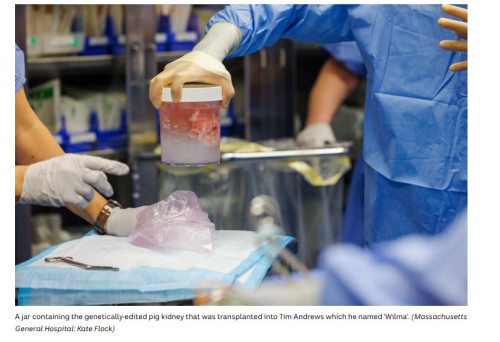- Joined
- Aug 20, 2022
- Messages
- 22,074
- Points
- 113
https://www.abc.net.au/news/science/2025-09...ecord/105784644
Pig kidney recipient Tim Andrews breaks GM xenotransplant records
In short:
A US man who received a gene-edited pig kidney has lived a record-breaking eight months without his body rejecting the organ.
Six people around the world have received gene-edited pig kidney transplants in recent years.
What's next?
Expanded clinical trials of pig kidney transplants will start in the US this year and other researchers are exploring the viability of porcine lung and heart transplants.

For eight months US man Tim Andrews has been living with a pig kidney in his body.
"Sometimes it's the only thing I can think about, keeping Wilma alive," he said.
"Wilma is my kidney, we named her when we got her, and I take care of her."
Before his transplant at the end of January this year, Mr Andrews had been on dialysis for two years after an end-stage kidney disease diagnosis.
He was told by doctors that the average extension of life on dialysis was five years.
But with his rare O-type blood Mr Andrews was looking at a seven-year wait for a human kidney to become available. A two-year difference which he joked was "a little bit of a gap".
More than 100,000 people are on a waitlist for an organ transplant in the US, and 89,000 of them need a kidney.
Thirteen people from the list die each day.
So Mr Andrews decided to take a different route: experimental surgery at Massachusetts General Hospital in Boston to receive an animal organ genetically altered by scientists that, hopefully, would not be rejected by his body.
Organ transplants were then attempted in 1906 by another French doctor who attached a pig or goat kidney to the elbow of two different patients.
Both surgeries failed after three days due to blood clots.
Up until 1996, most attempts at pig and monkey kidney transplants into people lasted from a few hours to 70 days. Although there was one outlier in the 1960s where a woman lived for nine months after receiving a chimpanzee kidney.
The problem in most of these cases was that human bodies quickly rejected these organs because of their genetic differences.
Greater success has been seen in the field of xenografts where skin, bone and tendons from animals, which can be sterilised or decellularised, has been adopted in medicine.
Treatment Animal materials used
ACL (knee) repair Pig tendons
Dental bone grafts Cow and pig bones like femurs
Skin wraps for burns Fish, cow and pig skin
Heart valve repair Cow, pig and horse pericardium
Rotator cuff (shoulder) repair Cow pericardium and pig skin and intestine
And now, eight months later, the 67-year-old has nearly doubled the previous record for living with a functioning pig kidney.
"I'm aiming for a year," Mr Andrews said. "I take it by day but that's my next hope.
"Because then it's worthwhile to take these kidneys and start using them so people can get out of that situation [dialysis] for at least a year."
Going over the six-month milestone is exciting researchers in the field of animal-to-human organ transplants, known as xenotransplantation.
Pre-clinical trials will soon ramp-up in the US with eGenesis, the biotech company that edited Wilma, receiving approval to do more transplants with 33 people over the age of 50 with end-stage kidney failure.
Another US company, United Therapeutics, has approval to trial up to 50 transplants with their own modified pig kidney.
Xenotransplantation researcher Wayne Hawthorne, a professor of transplantation at Westmead Hospital in Sydney, said it was exciting to see how far the field had come.
He said CRISPR had helped the field jump forward to be making multiple gene edits quickly.
"And as they [procedures] improve and the outcomes are extended for these patients, we'll actually be able to transplant more patients," he said.
"I think it's self perpetuating, the more we do, the better we get, the more we'll be able to do."
A long and controversial history
So how did we get to this point that a pig kidney could be placed into a completely different species of mammal?
The idea of xenotransplantation and transfer of living tissue between species goes right back to at least the 17th century.
One of the earliest recorded cases of an animal to human surgery was in 1667 when a French physician performed a blood infusion from a lamb into a 15-year-old boy.
The child survived. Others did not and France put a moratorium on blood transfusions a few years later.

Pig kidney recipient Tim Andrews breaks GM xenotransplant records
In short:
A US man who received a gene-edited pig kidney has lived a record-breaking eight months without his body rejecting the organ.
Six people around the world have received gene-edited pig kidney transplants in recent years.
What's next?
Expanded clinical trials of pig kidney transplants will start in the US this year and other researchers are exploring the viability of porcine lung and heart transplants.

For eight months US man Tim Andrews has been living with a pig kidney in his body.
"Sometimes it's the only thing I can think about, keeping Wilma alive," he said.
"Wilma is my kidney, we named her when we got her, and I take care of her."
Before his transplant at the end of January this year, Mr Andrews had been on dialysis for two years after an end-stage kidney disease diagnosis.
He was told by doctors that the average extension of life on dialysis was five years.
But with his rare O-type blood Mr Andrews was looking at a seven-year wait for a human kidney to become available. A two-year difference which he joked was "a little bit of a gap".
More than 100,000 people are on a waitlist for an organ transplant in the US, and 89,000 of them need a kidney.
Thirteen people from the list die each day.
So Mr Andrews decided to take a different route: experimental surgery at Massachusetts General Hospital in Boston to receive an animal organ genetically altered by scientists that, hopefully, would not be rejected by his body.
Organ transplants were then attempted in 1906 by another French doctor who attached a pig or goat kidney to the elbow of two different patients.
Both surgeries failed after three days due to blood clots.
Up until 1996, most attempts at pig and monkey kidney transplants into people lasted from a few hours to 70 days. Although there was one outlier in the 1960s where a woman lived for nine months after receiving a chimpanzee kidney.
The problem in most of these cases was that human bodies quickly rejected these organs because of their genetic differences.
Greater success has been seen in the field of xenografts where skin, bone and tendons from animals, which can be sterilised or decellularised, has been adopted in medicine.
Treatment Animal materials used
ACL (knee) repair Pig tendons
Dental bone grafts Cow and pig bones like femurs
Skin wraps for burns Fish, cow and pig skin
Heart valve repair Cow, pig and horse pericardium
Rotator cuff (shoulder) repair Cow pericardium and pig skin and intestine
And now, eight months later, the 67-year-old has nearly doubled the previous record for living with a functioning pig kidney.
"I'm aiming for a year," Mr Andrews said. "I take it by day but that's my next hope.
"Because then it's worthwhile to take these kidneys and start using them so people can get out of that situation [dialysis] for at least a year."
Going over the six-month milestone is exciting researchers in the field of animal-to-human organ transplants, known as xenotransplantation.
Pre-clinical trials will soon ramp-up in the US with eGenesis, the biotech company that edited Wilma, receiving approval to do more transplants with 33 people over the age of 50 with end-stage kidney failure.
Another US company, United Therapeutics, has approval to trial up to 50 transplants with their own modified pig kidney.
Xenotransplantation researcher Wayne Hawthorne, a professor of transplantation at Westmead Hospital in Sydney, said it was exciting to see how far the field had come.
He said CRISPR had helped the field jump forward to be making multiple gene edits quickly.
"And as they [procedures] improve and the outcomes are extended for these patients, we'll actually be able to transplant more patients," he said.
"I think it's self perpetuating, the more we do, the better we get, the more we'll be able to do."
A long and controversial history
So how did we get to this point that a pig kidney could be placed into a completely different species of mammal?
The idea of xenotransplantation and transfer of living tissue between species goes right back to at least the 17th century.
One of the earliest recorded cases of an animal to human surgery was in 1667 when a French physician performed a blood infusion from a lamb into a 15-year-old boy.
The child survived. Others did not and France put a moratorium on blood transfusions a few years later.

